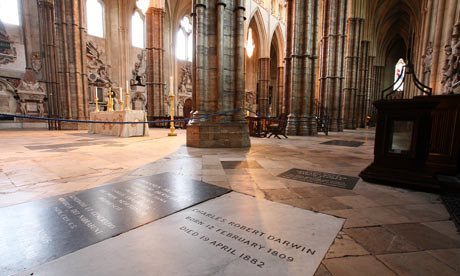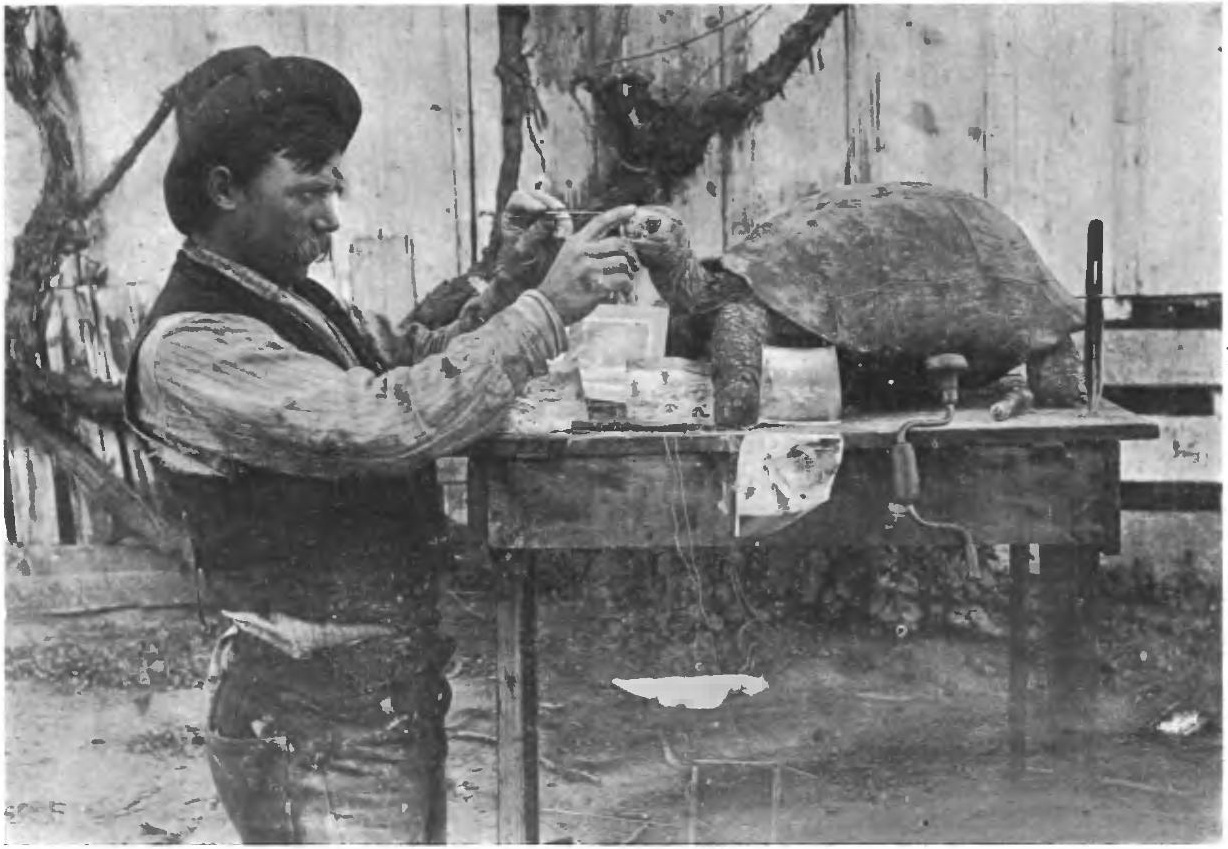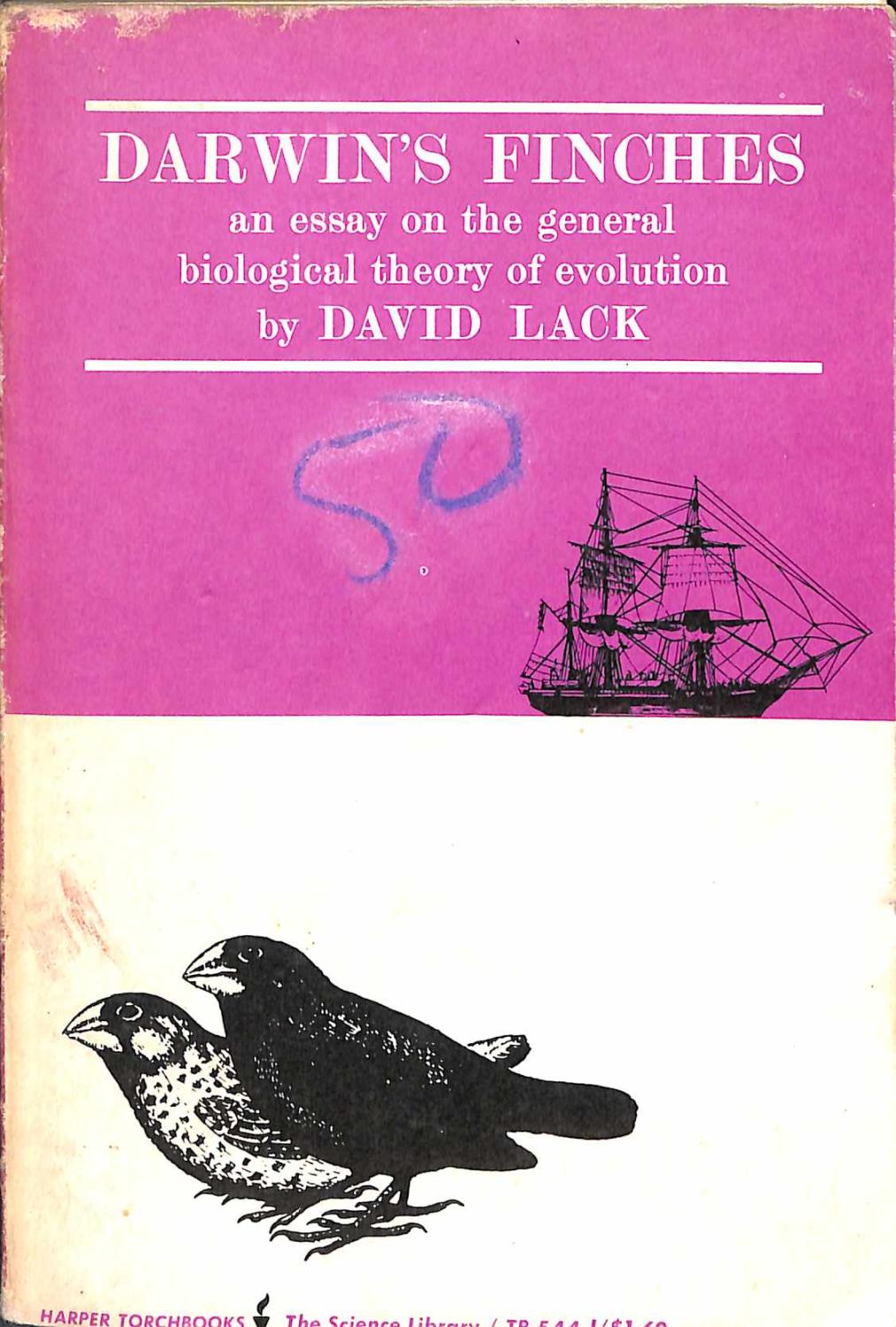 Mr Charles Darwin
Mr Charles Darwin
Westminster Abbey
20 Deans Yd
Westminster
London SW1P 3PA
UK
My Dear Charles (if I may)
Happy 209th birthday!
I know that a few people have written to you [1] in the 132 years since you shuffled off this mortal coil, but I thought it high time we brought you up to date on the research inspired by those drab little finches that you collected in the Galápagos Islands. I am not really sure how long it takes for letters to reach you at your new address [2] but the current evidence suggests that it might take forever. But still…
You presumably know about the several Galápagos expeditions that took place during your lifetime. As soon as John Gould had figured out that there were actually 12 species of finches in your collection, and that there were different combinations of species on different islands, the floodgates were opened.
You will remember poor old Thomas Edmonstone [3] who went to the islands on HMS Herald in 1845. You had asked him specifically to collect finches from as many different islands as he could visit and to keep careful records as to which specimens were from which island, as you had not properly labelled all of your own finch specimens. Sadly, he died on that voyage and his records were virtually indecipherable.
Then Simeon Habel went out in 1868 and stayed for 6 months, making an extensive bird collection that ended up in Vienna. Percy Sclater and Osbert Salvin [4] published a little about that collection. Finally, your old nemesis, Luis Agassiz [5], went to the islands for only 9 days in 1873 but his crew still collected a lot of specimens for the Harvard Museum of Comparative Zoology. Agassiz, as you no doubt expected, could not see what all the fuss was about over the finches and remained a devout creationist.
It has always been pretty clear to me that the finches fascinated you. Even in your notes from the Beagle voyage you could already tell that they were closely related to some mainland species and realized that they were all related, even if, at the time, you thought that many of the finches on different islands were just morphologically differentiated races of the same species. As you said in your ‘Ornithological Notes‘:
These birds are closely allied in appearance to the Thenca of Chile or Callandra of la Plata. In their habits I cannot point out a single difference; — They are lively inquisitive, active run fast, frequent houses to pick the meat of the Tortoise, which is hung up, — sing tolerably well; are said to build a simple open nest. — are very tame, a character in common with the other birds…I have specimens from four of the larger Islands; the two above enumerated, and (female. Albermarle Isd.) & (male: James Isd). — The specimens from Chatham & Albermarle Isd appear to be the same; but the other two are different. In each Isld. each kind is exclusively found: habits of all are indistinguishable… When I see these Islands in sight of each other, & possessed of but a scanty stock of animals, tenanted by these birds, but slightly differing in structure & filling the same place in Nature, I must suspect they are only varieties. (Darwin 1963)
In 1888 and 1891, Zera L. Tanner took several naturalists (including Aggasiz’ son Alexander) on his fisheries research ship USFC Albatross to the islands to collect specimens. The bird specimens in those collections, as well those of Habel and Bauer and Adams in 1891, were studied by the great American ornithologist Robert Ridgway [6] and published in his Birds of the Galapagos Archipelago in 1896. Ridgway recognized that despite all of the previous visits to the islands, not much was really known about the finches still:
Not a single island of the group can be said to have been exhaustively explored, and few of the species are known in all their various phases in fact, many are known only from a few specimens in female or immature dress. No observations have been made upon the attitude the different species of Geospiza maintain toward one another tending to show how far the differences observable, or thought to be observable, in dried specimens indicate the actual grouping in species of living individuals. The anomaly of individuals adult as to plumage but with bills suggesting immaturity’, and of others which show exactly the reverse, remains to be explained and there are other questions which only protracted field-studies by a competent investigator can decide. Until all these present mysteries are solved, theories and generalizations are necessarily futile. (Ridgway 1897: 459-460)

The indefatigable Rollo Beck of California was the next ornithologist to make collections in the Galeapagos when he was sent there by Lord Walter Rothschild [7] specifically to collect tortoises that were sent back to Rothschild’s collection at Tring (UK). Beck was sent back to the islands in 1905 to collect for the California Academy of Sciences, and stayed for a whole year. He shipped 78,000 specimens (including 8688 birds [8]) back to the Cal Academy, a third of which were finches.
Percy Lowe went out in 1936 but declared in his paper published in The Ibis that the finches were all a kind of hybrid swarm with no clear evidence of speciation. He did, however, call the birds ‘Darwin’s Finches’ and you will undoubtedly be delighted to know that that name endures to this day despite a few subsequent publications calling them ‘Galapagos Finches’.
 In 1938-39, a school teacher named David Lack spent four months on the islands studying the behaviour of the fiches, followed by a few months studying the extensive collection of specimens at the Cal Academy. Lack was already a well-known, if amateur, ornithologist having participated in some ornithological expeditions and published a few papers. Lack was appointed Director of the Edward Grey Institute of Field Ornithology in 1945, a position he held until he died in 1973. In 1940 he published the results of his Galápagos studies in a paper in Nature and later, in 1947, in a book called Darwin’s Finches. Lack really established the finches as model organisms for the study of evolution.
In 1938-39, a school teacher named David Lack spent four months on the islands studying the behaviour of the fiches, followed by a few months studying the extensive collection of specimens at the Cal Academy. Lack was already a well-known, if amateur, ornithologist having participated in some ornithological expeditions and published a few papers. Lack was appointed Director of the Edward Grey Institute of Field Ornithology in 1945, a position he held until he died in 1973. In 1940 he published the results of his Galápagos studies in a paper in Nature and later, in 1947, in a book called Darwin’s Finches. Lack really established the finches as model organisms for the study of evolution.
To some extent inspired by Lack’s book, Robert Bowman [9]—a Queen’s University graduate—went first went to the Galápagos in 1956 and returned several times to conduct a series of studies designed in part to show that Lack was mistaken about the role of competition in the evolution of the finches. Bob did his PhD at UC Berkeley, carefully describing the skulls and jaw musculature of the finches. Later he studied their songs and concluded that those species that coexisted in the same island differed as much in their songs as they did in their bills, and that the songs probably reduced the incidence of ‘cross-breeding’ as you called it.
Finally (though not actually the end of the story), a personal note. In the fall of 1973, my PhD advisor, Peter Grant, who was then studying competition in microtine rodents, came into our grad student office and asked me if I’d like to go to the Galápagos to suss out the finches as a possible focus for my thesis research. I had just started a PhD program at McGill University a couple of months earlier and was thinking then that I wanted to return to Newfoundland or the high arctic, as I had worked studying seabirds for the Canadian Wildlife Service in both places in the preceding summer. Peter and his postdoc  Ian Abbott were going to the Galápagos for a few weeks mainly to study the interactions between the birds and the seeds of Tribulus, which formed a large part of their diet. For several reasons I declined, but Peter (with Ian and his wife, Lynette) went and was enchanted, thereby beginning the longest running—and today probably best known—series of studies of ‘your’ finches. His work was the subject of a Pulitzer prize winning book called The Beak of the Finch. I am certain that you would be stunned by the quality and breadth of the work that Peter, his wife Rosemary, and their students and colleagues have accomplished in the intervening 45 years.
Ian Abbott were going to the Galápagos for a few weeks mainly to study the interactions between the birds and the seeds of Tribulus, which formed a large part of their diet. For several reasons I declined, but Peter (with Ian and his wife, Lynette) went and was enchanted, thereby beginning the longest running—and today probably best known—series of studies of ‘your’ finches. His work was the subject of a Pulitzer prize winning book called The Beak of the Finch. I am certain that you would be stunned by the quality and breadth of the work that Peter, his wife Rosemary, and their students and colleagues have accomplished in the intervening 45 years.
I am actually in Ecuador today in the cloud forest nw of Quito, watching birds with a couple of old friends, Tim Birkhead (sperm competition [10], history of ornithology) and David McDonald (manakins). Tim and I will fly [11] to Baltra on Thursday the 15th to tour the islands for a few days. I will send you some photos and field notes next Monday from our trip. That post might be delayed by a day or two depending upon the quality of the internet connection [12] on our boat or in Guayaquil. I know you did not get to the mainland of Ecuador in 1835 but I think that history has shown that your time was better spent in the Galápagos.
Yr obd svt
Bob Montgomerie
Sources
- Darwin CR (1963) Ornithological notes. Barlow N. , editor. British Museum (Natural History) Bulletin, Historical Series 2: 201–278.
- Lack D (1947) Darwin’s Finches. Cambridge: Cambridge University Press.
- Lowe PR(1936) XV.—The finches of the Galapagos in relation to Darwin’s conception of species. Ibis 78: 310–321, doi:10.1111/j.1474-919x.1936.tb03376.x
- Ridgway R (1897) Birds of the Galápagos archipelago. Proceedings of the U. S. Nayional Museum 19:459–670.
- Sclater PL, Salvin O (1870) Characters of new species of birds collected by Dr Habel in the Galapagos Islands. Proceedings of the Zoological Society of London 38:322–323.
- Ridgway R (1897) Birds of the Galápagos archipelago. Proceedings of the U. S. National Museum 19:459–670.
FOOTNOTES
1. see photo at the top, but also, if you modern readers of this post are familiar with the what3words app or website, Darwin is at, or very close to, salsa.snap.finger
2. see for example a letter from Jerry Coyne on the Oxford Press blog in 2009 here; and a letter from Frank Gannon in EMBO Reports, also in 2009, here
3. 1825-1846; sometimes spelled Edmonston; he was accidentally shot in the head after landing in Peru, right after visiting the Galapagos
4. Sclater (1829-1913) and Salvin (1835-1898) were both prominent 19th century English ornithologists who were original members of the BOU and editors of The Ibis. Together they published the first paper to appear in The Ibis
5. Agassiz(1807-1873) was born and raised in Switzerland but moved to the USA in 1847 and eventually became professor of zoology at Harvard where he founded the Museum of Comparative Zoology.
6. Ridgway (1850-1929) was one of the founders of the AOU (now AOS) and was president of the AOU from 1898-1900
7. Rothschild (1868-1937) was a wealthy collector who donated his Tring estate to the British Museum, where it is now a division of the Natural History Museum and sold his bird specimens to the American Museum of Natural History, thereby establishing the AMNH as a leading ornithological centre worldwide.
8. About 2500 of these were finches in the genus Geospiza alone (data from VertNet accessed on 4 Feb 2018)
9. Bowman (1925-2006) first went to the islands as a grad student, then several more times during his long career as a professor at San Francisco State University until he retired in 1988.
10. It wasn’t until 1970 that Geoff Parker added this interesting way that males compete to your list of important mechanisms of selection.
11. I don’t know if you are aware that we humans can now fly from place to place in giant buses with wings called airplanes, making it possible to get from my home in Canada to the Galápagos in less than a day. The first airplane flew to the Galapagos in 1934 to rescue a naturalist who had contracted appendicitis.
12. I don’t even know where to start explaining this. It’s like the mail without the paper, and messages are transferred instantly (which is both a boon and a curse) across the ether, so you are actually likely to encounter them wherever you are.
COMMENTS